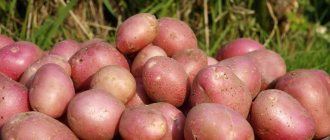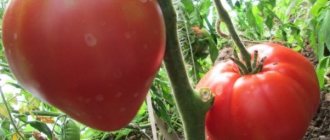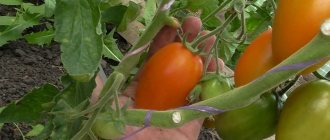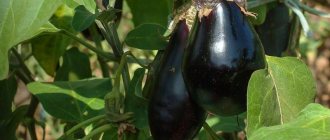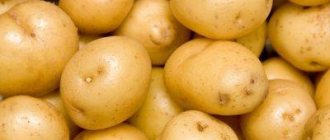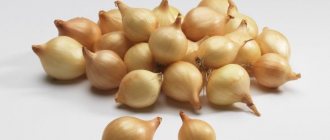Description and characteristics of the variety
The Hostess potato was created in Russia by specialists from the Siberian Research Institute of Potato Farming. The Sante and Zarevo varieties were taken as a basis. In 2009, the vegetable was included in the Russian State Register. It is zoned in the West Siberian and East Siberian regions, but in addition to cold regions it can be grown in the middle zone and in the south. In the southern regions, good watering is desirable.
The variety is mid-season, fully ripens in 80-100 days after planting. With good care, the bush produces 12-18 tubers. Plants are tall, semi-erect, intermediate type. They are covered with large leaves with wavy edges. The inflorescences are light purple.
The variety is resistant to various climatic conditions, temperature changes, cold, drought and mechanical damage.
Properties of tubers:
- weight 100-180 g;
- oval shape;
- red or pink skin with small or medium eyes;
- creamy flesh;
- contains a lot of starch - 17-22%
- Potatoes make a tender puree with an excellent taste; they are also used for baking and frying;
- the flesh does not tend to darken;
- keeping quality 95%;
- marketability is high - 87-97%.
The pulp contains many valuable substances - vitamins A, B, C, microelements - phosphorus, potassium, calcium, as well as fiber and carotene.
Origin, development and description
The Hostess variety is described as a mid-season table variety. It was bred at the Siberian Research Institute of Agriculture by domestic scientists. To create this variety, varieties such as Zarevo and Sante were used. Potatoes were included in the State Register of the Russian Federation in 2009.
Ripening time and yield
Due to its characteristics, the Khozyayushka potato variety ripens in approximately 80-90 days. If the crop is grown in regions with a cold climate, it will take longer to ripen, about 100 days.
One of the main advantages of this potato is its high yield. With proper planting and proper care, you can get from 12 to 18 tubers from one bush.
What do Khozyayushka potatoes look like?
For your information! Farms receive at least 600 centners of potatoes per 1 hectare.
Disease resistance
Potatoes of this variety are not afraid of diseases such as potato canker, cyst nematodes and golden nematodes. The culture is moderately resistant to rhizoctonia and late blight.
Characteristics of tubers
The average weight of tubers varies from 100 to 150 g. These are purple or pink potatoes with an oval-round shape. The skin of the tubers is smooth and thin, the flesh is creamy.
The bushes grow about 50 cm in height. They are erect with a lot of leaves. The leaves are large emerald green with jagged edges.
What regions is it suitable for?
Khozyayushka potatoes are classified as a variety adapted for cultivation in almost all regions of Russia. The following are considered the most favorable:
- southern;
- central;
- southern Siberia.
Note! It is not recommended to grow the variety in cold regions, since it is not possible to plant potatoes on time, and it is strictly forbidden to be late in planting, as this leads to a significant reduction in yield.
Taste qualities
The Hostess potato is a table variety. The tubers have an excellent taste. They do not darken during heat treatment.
Advantages and disadvantages
Pros:
- excellent taste;
- tender pulp;
- resistance to cold, temperature changes and droughts;
- possibility of long-term storage without loss of quality;
- large tubers, among which there are few non-commercial small things;
- possibility of transportation over long distances;
- high productivity;
- content of nutrients;
- immunity to diseases and nematodes.
Minuses:
- may suffer from late blight;
- in unfavorable conditions, tubers may crack or become small.
Pros and cons of the variety
The Khozyayushka variety has many advantages, which explains its great demand among gardeners.
pros
- Unpretentiousness to growing conditions.
- Excellent taste.
- The productivity of the variety is at a high level.
- Drought resistance.
- Good transportable properties.
- Long shelf life.
Minuses
Among the disadvantages of the Hostess potato, it is worth highlighting the following facts:
- Tubers are prone to cracking.
- Low resistance to late blight.
Landing
Potatoes are planted after the end of frost. The tubers need to be pre-processed and germinated:
- Small, but not the smallest, specimens are selected in advance for planting.
- Lay them out at a temperature of +10-15 degrees.
- Provide sunlight and allow germination.
- Before planting for germination or after it, tubers are treated with fungicides and stimulants.
- Treatment with stimulants is advisable before germination. You can soak root vegetables in a warm solution, warming them up at the same time.
- Before planting, tubers are sprayed with fungicides.
In Siberia and other cold regions, potatoes are planted as soon as the frosts end, so as not to be late with planting. If you plant half a month later, there is a risk of losing half the harvest.
In the fall, prepare and dig up the soil, add 5-10 kg of organic fertilizers (humus or compost). The amount depends on the condition of the soil.
In spring, mineral fertilizers containing phosphorus and potassium are applied.
Potatoes require a site in the sun without groundwater, which is close to the surface. If groundwater is close to the region, it is recommended to plant potatoes in ridges. The same method is used for very dense soils.
Planting pattern - 30 by 70 cm.
Planting and growing potatoes
You can get a good harvest only if you follow all the rules for growing and caring for the crop.
Preparing for landing
Experienced gardeners recommend planting sprouted tubers of this potato. To do this, you need to remove it from the storage location approximately a few weeks in advance and place it in a room where the temperature is from 12 ° C to 15 ° C. Before planting, you need to treat the tubers with a solution of potassium permanganate or spray them with copper sulfate.
Soil requirements
Hostess is not a demanding variety when it comes to soil, but the best yield is observed if the crop is grown in sandy or loamy soil with the addition of black soil. In petrified soil, root crops grow relatively poorly.
Dates, scheme and rules of planting
The most optimal time for planting potatoes is May. It is imperative to wait until the frosts have passed and the soil has warmed to a depth of 10 cm to 8 °C.
Important! Potatoes should be planted at a distance of at least 35 cm from each other, leaving a gap of 50 to 60 cm between the rows. The depth of the hole should be about 7-10 cm. Under these conditions, the potatoes will be provided with space for normal growth.
Growing and care
Although potatoes are drought tolerant, watering helps increase yield. To do this, you need to water it during the following periods:
- one to two weeks after germination;
- with the appearance of the first buds;
- when the flowers fall off.
Use warm water. During drought, water the soil generously, to a depth of 50 cm, preferably in the evening.
Hill up the bushes 2-3 times per season. The first time is a week after the tops appear. The lower part of the bush is sprinkled with moist soil. Repeat after 2-3 weeks. In dry soil, hilling is not carried out.
Feed twice. The first time, add 2 tablespoons of chicken droppings or wood ash to 5 liters of water and water the bushes 2 weeks after germination. Re-irrigate at the beginning of flowering with a solution of 2 tbsp. l. superphosphate and 1 tbsp. l. nitrophoska for half a bucket of water.
After the flowering period, root feeding is not carried out, otherwise nitrates may remain in the tubers. Fertilizers are applied only to moist soil.
Weeds are weeded as they appear.
Proper care
Potatoes are the easiest crop to grow. Everything you need to get a good harvest:
- Water several times.
- Hill up several times.
Watering
Watering should be systematic. The Hostess potato is very responsive to watering, but does not like strong moisture (like any other variety). Experienced specialists have developed a standard irrigation scheme that will ensure maximum efficiency.
- It is not recommended to water potatoes until the green part appears on the surface of the soil.
- The first irrigation is best done when the crop is sufficiently strong. That is, the stems of the tops rose 10 cm above the ground level.
- The second irrigation is carried out after the appearance of inflorescences.
- Final watering is carried out before/immediately after the disappearance of the inflorescences.
In general, three waterings per growing season are sufficient. The rest is up to the precipitation. If there is constant drought, then you can add 2-3 waterings.
As for later watering (after flowering), they are not recommended, as there is a risk of late blight.
Hilling
Hilling performs a number of functions necessary for the normal development of the crop:
- When hilling, weeds are removed. At the initial stage of bush development, they dominate, inhibiting its growth. Removing weeds allows the tops to grow unhindered and the tubers to develop quickly.
- Hilling loosens the soil, saturating it with oxygen. In addition, in dense soil, tubers develop much more slowly.
- Hilling up protects the green part of the crop from sticking to the ground and drying out prematurely.
As you can see, hilling plays an important role in the development of culture. Moreover, experienced experts note that if you do not hill up potatoes, you can lose up to 25-30% of the possible harvest.
The Mistress is spudded twice:
- When the sprouts have risen 20-25 cm.
- 3 weeks after the first procedure.
Diseases and pests
The variety is endowed with fairly strong immunity, but protection from diseases and harmful insects will not be superfluous.
Common scab
This is a fungal disease that affects tubers. To protect against it, spill the soil with a solution of Bordeaux mixture or other copper-containing fungicides, treat seed tubers with their solutions, and observe crop rotation.
Black scab
The fungus destroys the entire bush. To protect against it, avoid excess dampness near the bushes and protect them from heat, adhere to crop rotation and follow the rules of care.
Late blight
This is the most dangerous fungus that develops when there are changes in night and day temperatures and high humidity. For protection, the bushes are sprayed with copper-containing fungicides, and the soil and seed tubers are treated with them before planting.
Features of cultivation
“Hostess” is distinguished by its unpretentiousness. There are no special features when growing the plant. The most important thing is to follow the landing rules:
Landing rules
- before planting, it is necessary to add fertilizer to each hole;
- as a top dressing, use a kilogram of humus, two tablespoons of ash and nitrophoska;
- the fertilizer must be covered with two centimeters of soil on top, on which the potatoes will subsequently be laid;
- Potatoes must be sprouted in 1.5-2 weeks;
- the distance between tubers when planting should be at least 35 cm, between rows - at least half a meter (necessary for convenient hilling);
- the depth of the planting holes depends on the structure of the soil: the usual depth is 7-10 cm, but on clay soil it should be 2-3 cm less;
- as soon as the potatoes are planted, do not forget to level the beds with a rake (necessary to prevent the soil from drying out);
- If there is subsoil water nearby, potatoes must be planted in bulk “ridges” up to 2 tens of cm high.
Care
In order to get a good harvest, the “Housewife” potatoes must be properly cared for. To do this, you need to correctly carry out the following processes:
Weeding
Weeding is carried out in several stages. First, the shoots must be freed from weeds. After a few weeks, this process is repeated. As a result, the tops gain strength and do not need weeding, since the weeds “survive” on their own.
Watering
The frequency and intensity of watering depends on weather conditions. If the potato tops droop and wither, this indicates a lack of moisture in the soil. In order to replenish it, it is necessary to water the soil to a depth of half a meter.
Top dressing
Before you start hilling, you need to feed the plants twice. To do this, first add ash or a small amount of droppings mixed with soil under the bush. Next time, you need to pour a solution under the root of the plant, where a couple of spoons of superphosphate and one spoon of nitrophoska are diluted per 5 liters.
Important! It is impossible to fertilize the plant after flowering. Otherwise, nitrates will accumulate in the tubers.
Hilling
Hilling must be done before the plant blooms. To do this, young shoots must be covered with a 5 cm layer of soil. This will provide the potatoes with reliable protection from spring frosts.
Diseases and pests
The only disease to which “Hostess” has little resistance is scab. This plant appears at very high temperatures.
At the moment, the defeat of Scab in Siberia has still not been recorded.
In order to get rid of this disease, it is necessary to use fungicides.
It is important to remember that Scab spores can remain in one place for up to 3 years. That is why planting sites need to be changed regularly.
Disease resistance
Hostess potatoes have excellent resistance to diseases such as canker, golden nematode and cyst nematode. Average resistance to late blight and rhizoctonia.
Pests and diseases
The variety has good resistance to many potato diseases. The variety tolerates nematode viruses, cancer and other diseases well, but is not able to withstand such a scourge as scab. This problem occurs in tubers when grown at high temperatures.
Due to the fact that heat is a rare phenomenon in the majority of Russian regions in summer, the occurrence of this type of danger is minimized.
When scab is detected, fungicides must be used. It is worth considering that spores can survive in one place for 3 years. In this regard, it is recommended to change the planting area. The variety has average resistance to diseases such as late blight and rhizoctonia.
Necessary conditions for cultivation
To obtain a good harvest, it is necessary to create certain growing conditions:
- The landing site should be well lit.
- Choose light, loose soil; in wet and heavy soils, form drainage.
- Maintain crop rotation.
- Carry out preventive spraying against diseases and insects.
- Seed material is purchased from trusted sellers; the tubers must be intact, without black spots or cracks.
- On fertile soils the yield is higher.
- Potatoes prefer soil with medium acidity.
See also
Description and characteristics of Rodrigo potato variety, cultivation and care
Read
Harvest and storage
Collection and storage of Hostesses have their own characteristics.
How and when to collect
Hostess belongs to the mid-late varieties. The harvest is harvested in September. About a week before digging, the tops are mowed, which stimulates the flow of nutrients to the tubers. Harvesting is carried out in dry sunny weather; after harvesting, the tubers are ventilated for several hours outside, but not in direct sunlight. Store potatoes in a cool, dry place.
Specimens selected for planting are left in the open air longer, stimulating the synthesis of solanine. Greened potatoes will be protected from diseases and pests, their germination and productivity will increase.
Attention! Green potatoes should not be eaten!
Storage features and keeping quality of the variety
The variety has excellent keeping quality - more than 90%. Tubers do not have a tendency to germinate. Under favorable conditions it can be stored for six months or longer.
Advice from experienced gardeners and reviews about the Hostess variety
Summer residents love this variety and share their tips and impressions with readers.
Yulia, Moscow region : “A neighbor shared planting material with us - it was the Hostess. Now she pleases us with a stable harvest every year. My husband and I have been growing it on our plot for more than five years. The taste is excellent. I don’t recommend it for frying, as it crumbles.”
Elena, Sverdlovsk region : “Two years ago we tried to plant Khozyayushka and we liked this variety. We were pleased with its productivity - a large number of tubers from one bush, thanks to which even in a small area you can get a good harvest. We like to make mashed potatoes from these potatoes; they are also good for soup, but they are not very suitable for frying - they start to crumble.”
Nikolay, Chelyabinsk region : “We tried many varieties at our summer cottage, but settled on the Hostess variety. Since this variety of potatoes does not require special care and gives good results regardless of the weather. I also liked the small number of spoiled tubers during winter storage. I recommend planting Hostess in a well-lit area and after perennial herbs.”
Description of the variety
Ivan da Marya grows on any soil, but prefers light soils with little acidity. Potatoes owe their beautiful Russian names to their external characteristics. The late ripening variety has tall, erect bushes, under each of which up to 20 tubers are tied:
- elongated shape;
- with yellow skin;
- with pink spots;
- with small eyes.
One potato weighs about 100 grams, and the pulp contains almost 16 percent starch. It contains many vitamins and microelements such as iron, calcium, magnesium, selenium, and potassium. The tuber contains slightly less than 80 kcal. The root vegetable has a pleasant taste and softens during heat treatment.
The plant is not affected:
- potato cancer;
- nematodes;
- verticillium wilt.
Over 300 centners of potatoes are dug from one hectare in different regions of Russia. Root crops ripen 110–135 days after the sprouts emerge. The ripening period is influenced by:
- soil features;
- weather;
- agricultural technology.
As follows from the description, the Ivan-da-Marya potato tolerates drought well, the tubers are perfectly stored until the next harvest, used fried, boiled, baked, and used to prepare soups, borscht, and casseroles.
The flowers of the Ivan-da-Marya variety are not collected in brushes, have a white tint, and shimmer with a purple color. The smooth, attractive tubers are quickly sold out on the market and remain in the cellar until spring.
Gardeners and farmers enjoy growing Ivan da Shura, a variety that was bred by Kaluga breeders. The root crops of this variety ripen earlier than 4 months after the sprouts emerge. From 15 to 20 smooth, oval-shaped tubers are dug from the bush. The white pulp contains up to 17% starch and contains amino acids and vitamins.
The advantages of the variety include:
- yield over 750 centners per hectare;
- rapid ripening;
- delicate taste.
Potatoes are boiled and used to prepare various dishes. The crop is resistant to the main diseases of nightshades, is not afraid of drought, but is demanding on soil fertility.
Growing the Hostess variety
Seed potatoes are germinated within a month. They are laid out in vegetable boxes in one layer and treated with a growth stimulant - Poteytin, Epin, Bioglobin. These preparations are used to treat vegetative bushes before flowering.
Advice! There is no need to cut seed potatoes; it is better to select medium-sized Hostess tubers for planting.
Stimulants improve the quality of the crop, prevent the development of late blight, and increase the resistance of Khozyayushka potatoes to pests. They help save potatoes from the Colorado potato beetle. Potatoes are germinated at a temperature of 20-25 °C. The boxes are covered with a damp cloth to prevent the tubers from drying out. By the time of planting, strong shoots appear from the eyes.
Summer residents and farmers use different planting methods. Hostess potatoes are planted:
- into the ridges;
- trenches;
- under straw mulch.
Landing of the Hostess
Choose a sunny, not damp place. Planting begins after the soil has warmed up. Each region of Siberia has its own deadlines. The tubers have time to ripen when planted in early June, so the Hostess is planted from the beginning of May to the first days of June.
Before planting, assess the readiness of the soil. Its temperature should not be lower than 8 °C at a depth of 15 cm. Young tops are afraid of return frosts. This fact must be taken into account when planning planting operations.
Productivity is higher if the soil characteristics are as follows:
- not heavy;
- breathable;
- moisture permeable;
- pH within 5.1-6 (neutral, slightly acidic).
The soil structure is improved if necessary. Simple methods:
- semi-rotted manure and compost at 3 kg/m² are added to sandy and sandy loam soil for digging;
- rotted sawdust, peat, sand are added to alumina and loam; the application rate (2-20 kg/m²) depends on the composition of the soil.
The manufacturer of the variety recommends adhering to the standard planting pattern (40 * 60 cm) and depth (10 cm). It is recommended to add ash (2-3 tbsp) and a handful of humus to the holes.
Care
High-quality care increases the yield of Khostesska potatoes. Watering, fertilizing, and timely hilling have a positive effect on the quality of tubers and their size. From the moment of emergence until the tops reach 20-25 cm, care consists of weeding and loosening the soil.
When the tops of the Hostess reach a height of 25 cm, the plot is watered abundantly, and after 1-2 days they are hilled. In temperate climates, this is a mandatory procedure; it can be replaced with mulch. Potato bushes can be covered with hay and straw in several stages. As a result, the thickness of the layer should be 20-25 cm. The tubers will turn green if it is thinner.
Water the Hostess potatoes at least 3 times:
- before hilling;
- during the formation of buds;
- during mass flowering.
Watering is combined with scheduled fertilizing. Potato bushes are fertilized at the root or leaf by leaf. They use folk recipes (infusion of mullein, herbs, ash), simple (urea, superphosphate, potassium sulfate) or complex (nitrophoska) fertilizers.
Advice! The harvest is protected from wireworms and mole crickets with Antikhrushch, Gromoboy, and Scorpio.
For symptoms of late blight and other fungal infections, Hostess bushes are treated with Bordeaux mixture and copper sulfate. Insecticides are used against the Colorado potato beetle, potato flea beetle and moth:
- Calypso;
- Anticolorad;
- Hunter.
Harvest and storage
Collection and storage of Hostesses have their own characteristics.
How and when to collect
Hostess belongs to the mid-late varieties. The harvest is harvested in September. About a week before digging, the tops are mowed, which stimulates the flow of nutrients to the tubers. Harvesting is carried out in dry sunny weather; after harvesting, the tubers are ventilated for several hours outside, but not in direct sunlight. Store potatoes in a cool, dry place.
Specimens selected for planting are left in the open air longer, stimulating the synthesis of solanine. Greened potatoes will be protected from diseases and pests, their germination and productivity will increase.
Storage features and keeping quality of the variety
The variety has excellent keeping quality - more than 90%. Tubers do not have a tendency to germinate. Under favorable conditions it can be stored for six months or longer.
Agricultural technology for planting potatoes
The hostess is suitable for growing in any way - both in open ground and under film. However, since the variety was conceived as highly resistant, suitable for cultivation in weather conditions close to extreme, it is most often grown in ordinary, unprotected beds, which requires much less expenditure from the gardener.
Optimal landing site
It is necessary to plant the Hostess in an open and well-lit place, where there is no swamp or close to the groundwater surface. The most successful option is to have a gentle slope to the south or southwest, then the garden bed will be reliably protected from the north.
If there is no slope, you can use tall plants, such as dense bushes or fruit trees, instead of natural relief protection.
Did you know? A folk sign allows you to determine the time for planting potatoes by the appearance of small, but fully opened leaves on the birch tree, or, if bird cherry grows near the site, by the beginning of its flowering.
Boarding time
Since the Hostess is initially aimed at growing in Siberia, it should be planted at the very end of spring or even at the beginning of summer.
However, it is more correct to focus in this matter not on the calendar, but on the degree of heating of the air and soil: the average daily temperature should be set at +8...+10 ° C, it is advisable to expect the same parameters from the soil at the depth of planting tubers (10–15 cm).
You can also adjust the planting time depending on the structure of the soil - the lighter it is, the faster it will warm up.
Soil preparation and requirements
For growing potatoes, fertile and not very heavy soil with good moisture and air permeability (ideally dried peat or black soil) and a neutral reaction - pH level in the range of 5.1–6 is best suited.
If the soil is too light, it will quickly dry out, simultaneously losing minerals due to their leaching, and heavy soil is dangerous due to stagnation of water in the roots, which is absolutely unacceptable for root crops.
However, with proper soil preparation, which is best done in the fall, the situation can be corrected:
- for sandstones or sandstones - by adding compost or manure in an amount of 1.5 to 3 kg per 1 sq. m for deep digging;
- for alumina or loam - adding peat, sand or sawdust in quantities of 2 to 20 kg per 1 sq. m (depending on soil composition).
Crop rotation
Crop rotation is a certain sequence of growing different crops in the same place, suggesting their ability to have different effects on each other. In particular, if plants share common pests or require the same nutrients that they actively extract from the soil, planting such crops one after another will lead to significant yield losses.
Conversely, some plants release certain substances into the soil that other crops especially need, in which case planting the latter after the former will ensure maximum productivity even without the use of additional fertilizers.
Find out also what is best to plant after potatoes.
As for potatoes (regardless of the variety), its possible predecessors, according to the rules of crop rotation, can be given the following assessment:
| Good predecessors | Bad Predecessors | Neutral predecessors |
|
|
|
Germination of planting material
It is advisable to plant the Hostess after preliminary germination. This procedure can last from 10 to 30 days. First of all, the tubers should be carefully examined, sorted, removing all specimens damaged by diseases or rodents, and calibrated by size.
You just need to try not to damage the sprouted tubers; all the others can be placed in a well-lit place with an air temperature of +20...+25°C, covered with a damp, light-colored cloth. Treatment (spraying) with growth stimulants, for example, “Epin”, “Regoplant”, “Kornevin”, “Bioglobin” or “Poteitin” will help to promote faster germination of tubers.
By the way, these same preparations can be used to spray bushes before flowering, this will improve the quality of the crop and give the plant additional protection from late blight, as well as the Colorado potato beetle and other pests.
Important! It is best to plant the hostess whole, without dividing the tuber into parts, so medium-sized potatoes should be selected for planting (small ones will give a poor harvest, and using large ones is not practical from an economic point of view).
Landing technology
From the point of view of planting technology, the Hostess differs little from any other potato variety. The depth of planting tubers should be from 10 to 15 cm, the traditional arrangement of bushes is 35x60 cm. Planting work begins with marking the site - using pegs to mark future rows, then within each row the place where the tuber will be planted is marked.
Then, according to the planned scheme, holes are dug to the required depth, 2-3 tbsp are added to each for disinfection and potassium fertilizing. l. wood ash, lay the tuber and fill the hole with earth.
There are, however, unusual ways of planting potatoes that can significantly facilitate the gardener’s work or obtain high yields in conditions that were initially poorly suited for growing this crop.
In particular, these include:
- Ridge method , which involves digging trenches in a bed and placing the excavated soil parallel to such a trench in the form of a kind of ridge. Holes for planting tubers are dug in the ridge, raised above the ground by about 15 cm, which helps protect root crops from high groundwater and facilitate air circulation in soils that are too heavy.
- Trench method , which consists in planting tubers not in separately dug holes, but in trenches and then sealing them using a walk-behind tractor. It is used over large areas using special equipment.
- Under straw - in this case, the tubers are simply placed on the ground and covered with straw, and as the bush grows, the layer of straw is constantly renewed. Allows you to get rid of the need to dig the ground both before planting and during harvesting.
- Under black film. The method is quite labor-intensive, but it allows you to completely solve the issue of subsequent soil care. The site of the future bed should be covered with dark agrotechnical fiber, then cross-shaped cuts should be made in it according to the usual planting pattern, a hole should be dug inside the cuts, a tuber should be placed in it and buried.
Weeds do not grow through such fabric, and the covering material, while perfectly allowing irrigation water to pass through, does not allow it to quickly evaporate, forming a dense crust that must be constantly loosened.
You can also try growing potatoes in boxes and bags.
Description of the Khozyayushka potato variety, growing characteristics and yield
Khozyayushka potatoes were the result of the selection of high-yielding varieties for cultivation in difficult climatic conditions. Growing such a crop in our country is a traditional activity for the majority of the population. Every year new potato varieties appear on the market, so it is often difficult to make the right choice. If you have any difficulties, experts advise paying attention to the Khozyayushka variety, which has a number of undeniable advantages over other varieties.
Description of the variety
The variety appeared as a result of many years of work by Russian breeders who worked on the creation of high-yielding crops. The species belongs to varieties with a medium-late harvest. A distinctive quality of the Hostess is considered to be high yield rates and, with proper care, one bush of the plant can produce from 12 to 18 tubers.
Description of potato variety:
- oval regular shaped tubers;
- thin pink peel;
- the eyes of root vegetables are small and light in color;
- When cut, vegetables have a creamy tint and do not darken during heat treatment;
- the average weight of one root vegetable is from 100 to 200 grams;
- The average starch content in potato tubers is 20%.
The bushes of the plant have an average height, the height of which reaches an average of 50 cm. The erect tops are characterized by an average amount of green mass, the leaf plates have a dark green color and a traditional shape with wavy edges.
Growing
An important role in obtaining good yield indicators is played by the selection of high-quality planting material and its preliminary preparation. The tubers should not show signs of rot or other visible defects. 1.5-2 weeks before planting, potatoes are taken to a darker room for germination; if possible, it is recommended to treat the tubers with drugs to reduce the risk of diseases and better formation of root crops.
Planting is carried out after the threat of frost has passed. The soil is well loosened and fertilizers are applied before placing the tuber in the hole. It is recommended to use the following recipe:
- humus 1 kg;
- 1 spoon of ash;
- 2 spoons of nitrophoska.
The fertilizer layer in the hole is covered with 2 cm of soil on top, after which potatoes are placed in it. The distance between seeds should be at least 35 cm, between rows - 0.5 meters. This planting scheme will further ensure ease of weeding and hilling and help increase productivity. The average planting depth for tubers is from 7 to 10 cm; if grown in soil with clay, potatoes are buried no more than 3 cm.
Features of care
The potato variety requires standard care techniques and is not characterized by any special features. At the first stages, the plant needs weeding; as it matures, the tops and root system become strong and “survive” the weed on their own. The first work is carried out when the bushes reach a height of 13 to 18 cm; after 2 weeks, the weed removal procedure is repeated.
The frequency of watering depends on the climatic conditions of cultivation. It is necessary to provide the plant with water in the absence of natural precipitation. A signal of a lack of moisture is wilting leaves and shriveled tops. In this case, abundant watering is carried out so that the water reaches a depth of half a meter.
Before hilling, feed the shoots twice. The first is to place ash or a small amount of droppings under each bush, which is pre-mixed with the ground. For the second time, prepare a solution of 5 liters of water, 2 tablespoons of superphosphate and 1 nitrophoska. After flowering, potatoes cannot be fertilized, since in this case nitrates will be present in the tubers. Hilling is carried out before flowering. To do this, the ground level is raised by an average of 5 cm using loosening.
Advantages or disadvantages
The potato variety is one of the few species that can tolerate low and high temperatures. The fruits have good taste qualities that are not lost even during long-term storage. The characteristics of the variety indicate the following advantages of the crop:
- versatility, the ability to use fruits for making purees, soups or cooking whole;
- ability to tolerate temperature changes well;
- high yield rates;
- keeping quality of fruits without loss of external and taste qualities up to 90%, ability to be stored unchanged for six months;
- ability to withstand difficult transportation conditions.
Potatoes are not prone to darkening after cutting, so they are well suited for making mashed potatoes and chips. On an industrial scale, flour and starch are made from it. The disadvantage of the variety is considered to be insufficient resistance to certain types of potato diseases and frosts. When grown in unfavorable conditions, reviews from gardeners note a tendency to cracks and increased formation of small tubers.
Pests and diseases
The variety has good resistance to many potato diseases. The variety tolerates nematode viruses, cancer and other diseases well, but is not able to withstand such a scourge as scab. This problem occurs in tubers when grown at high temperatures.
Due to the fact that heat is a rare phenomenon in the majority of Russian regions in summer, the occurrence of this type of danger is minimized.
When scab is detected, fungicides must be used. It is worth considering that spores can survive in one place for 3 years. In this regard, it is recommended to change the planting area. The variety has average resistance to diseases such as late blight and rhizoctonia.


